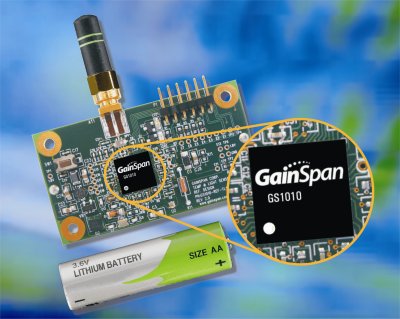Low-power chips bring WiFi to remote sensors
A Californian company claims to have overcome the power consumption problems that have so far prevented WiFi from being used to gather data from battery-powered sensors. Sunnyvale-based GainSpan Ė which was formed in 2006 as a spin-off from the chip-maker, Intel Ė claims that its technology will allow WiFi transmitters to operate for up to ten years, powered by a single AA battery.
Until now, sensor transmission networks have relied on dedicated technologies, often with a limited transmission ranges. Although there is a standardised wireless data transmission technology known as Wifi (defined in IEEE 802.11), it has a relatively high power consumption and has therefore not been suitable for collecting data from remote battery-powered sensors which, ideally, should be able to operate for long periods with no maintenance.
GainSpan says it has a found a way of implementing WiFi which has a much lower power consumption than normal, allowing transmitters to operate for several years before the single battery needs to be replaced. The advantages of using WiFi in this way include: seamless integration with existing WiFi networks; easy communications with higher-level systems; the wide availability of software tools; and potentially lower costs.

GainSpan, which has recently raised $20m-worth of funding, has been developing both the low-power custom chips (shown above), and the software development kits that will allow OEMs to implement the chips rapidly.
Harry Forbes, senior analyst at the ARC Advisory Group, believes that GainSpanís low-power WiFi technology has the potential to "change the game".
"While wireless sensor networks have seen steady growth over the past few years," Forbes points out, "their market potential has, in fact, been hindered by power consumption issues and lack of mature standard-based solutions". He suggests that GainSpanís development will allow users to take advantage of the global WiFi standard and existing network tools to provide "the cost, energy savings and convenience needed to transform this market".
Another analyst, Sam Lucero of ABI Research, points out that "WiFi is more widely used and understood than many sensor-networking technologies being developed. Rather than employ a dense cluster of meshed nodes, which are inherently more complex to network and manage, WiFi is a simpler start, reducing complexity of the network topology."
GainSpanís 10 x 10mm WiFi chips incorporate two 32-bit ARM7 microcontrollers, a real-time clock and power management functions, Flash and SRAM memories, and multiple I/Os. Potential applications are said to include motor monitoring, production tracking, meter reading and environmental observations. The chips will cost $15 in 10,000-unit quantities.





